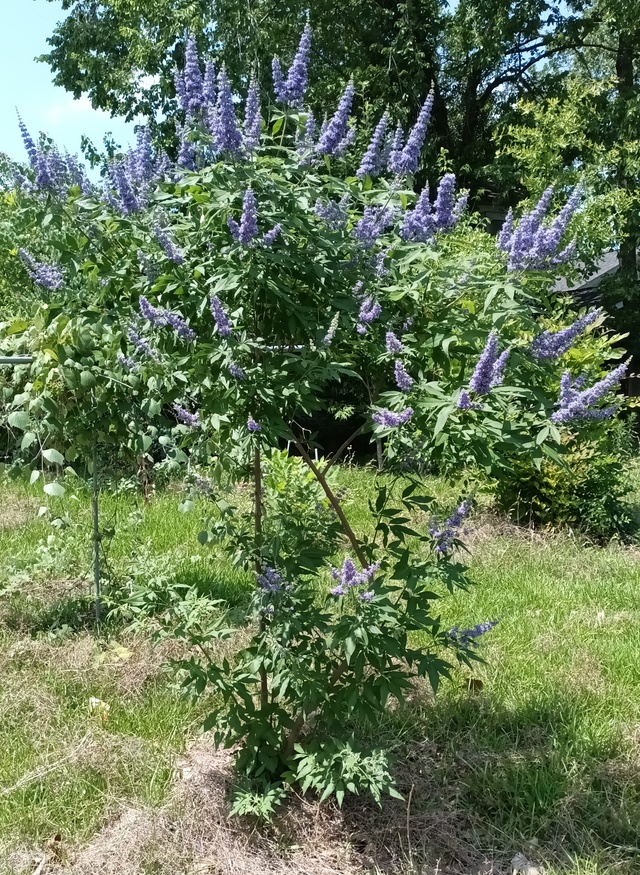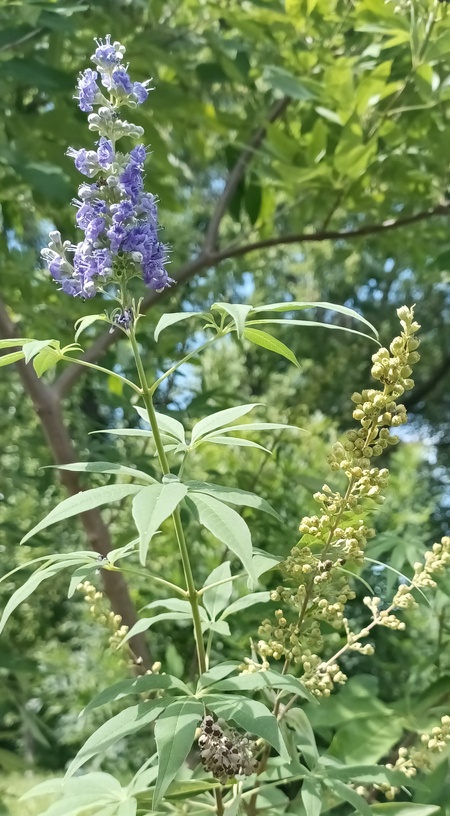Vitex: Chasteberry

This is about Vitex (chasteberry) and its hormonal properties for hormonal balance and for breast enhancement.
As a preview, chasteberry is useful for lowering hot-flashes when used once during mid to late luteal phase, but then it tends to cause breast swelling. It also tends to shorten the phase, causing menses to start soon after.
Etymology
Vitex agnus-castus and Vitex negundo have roles in traditional medicine for women's health. The plant of V. agnus-castus goes by chaste tree or sage tree. Fruits of V. agnus-castus are commonly known as chasteberry. Vitex trifolia and Vitex rotundifolia are other species within Vitex.
Vitex belongs to the Verbenaceae or Verbena family.
Properties

Vitex species of agnus-castus and rotundifolia are the ones known for hormonal properties. V. agnus-castus has been used successfully to treat hyperprolactima, premenstrual syndrome, and cyclical mastalgia (breast pain). It is uncertain if V. rotundifolia can be used in place of chasteberry.
Overuse of chasteberry reduces libido, as its name implies. From the evidence of Vitex agnus-castus' ability to lower prolactin, it is used for treating breast pain.
Chasteberry has various properties. In high doses, it lowers the pituitary's production of prolactin. In low doses, chasteberry increases prolactin production by the pitutary gland: this suggests resensitization by low amounts. During late secretory phase, it increases estrogen and balances progesterone levels.
Anecdotal evidence
Anecdotal evidence shows that modest amounts of chasteberry continue to lower prolactin symptoms after it is taken. During secretory phase, after recent signs of nipple growth, Vitex agnus-castus reduces nipple size and causes breast swelling. Chasteberry decreases prolactin, while simultaneously for the short term raises progesterone. Over time, this swelling goes away, because likely, prolactin production is continuing to be suppressed so that the feedback loop that increases progesterone eventually declines.
Once the temporary increase of progesterone is no longer sustained as a result of lowered prolactin levels, the premenstrual stage begins. These combined effects can explain why V. agnus-castus has been known to normalize the duration of the secretory (luteal) phase.
Anti-cancer properties
Many species within Vitex have anti-cancer properties.
Use
Vitex for breast enhancement

Chasteberry isn't recommended for herbal breast enhancement, because it regularly causes swelling, and it easily can cause shrinkage. Once there is swelling from taking chasteberry, taking more chasteberry may cause breast shrinking. Vitex can be used for improving hormone balance, but it's not recommended, because aside from it causing swelling, it causes menses to start sooner. Chasteberry may take from a few hours to over a day for a noticeable result of breast swelling.
If chasteberry is to be used, avoid it for menses and proliferative phase. A minimal amount Vitex can be used to lower acne during luteal phase. It often can only be used once per luteal phase, as it often causes menses to start.
Once there is swelling from taking chasteberry, taking more chasteberry may cause breast shrinkage. Taking vitex outside of secretory phase, may reduce estrogenic balance.
From the program hirsutism01, chasteberry has caused a temporary improvement for hormone balance. For a different method of taking Vitex every day, it perhaps works by averaging out hormones over time, provided that it doesn't interrupt the menses cycle, but this likely causes a reduction in size.
Vitex or herbs with similar properties are in herb programs based on menstrual phases. There must be balance throughout phases, and combinations of herbs help the body acheive balance for health, breast growth and hip growth. It's important that menses is light and short. Also, preventing an excess of negative symptoms for menses helps set the balance for proliferative phase. Luteal phase uses a different combination of herbs than proliferative phase for symptoms. For a simplified herb schedule, where there's commonality of herb recommendations for symptoms such as swelling and signs of excess estrogen, use nonmenses. BCP01 is a composite page of pieces of different programs on birth control or IUD use.
Herb timing and combinations' success for breast enhancement relies on menstrual phases. Descriptions and pictures of results from herb combination use can be seen in programs. For more guidance, see guide, or hirsutism-topic.
For hormone balance
Vitex can be taken once during late luteal phase to balance hormones. When used at this time, it can lower hot-flashes or excess body heat. Chasteberry tends to cause breast and other bodily swelling, and it also tends to cause menses to occur sooner. When vitex is used during proliferative phase, it doesn't tend to have the effect of alleviating hot-flashes and may possibly contribute to it.
In addition to when there may be hot-flashes during luteal, the best time of luteal phase to use vitex is once when there's acne. Fenugreek is a better replacement, which has been proven time and time again to reduce acne during luteal phase. To lower acne during proliferative phase, see the proliferative phase herb schedule. Vitex perhaps wouldn't have the desired result, if taken when there's breast swelling during luteal or any other time.
There are better herb combinations than vitex for improving hormone balance, that don't come with its negatives. They are included in the current herb programs of menses, nonmenses, proliferative and luteal under programs.
Similar herbs
Fenugreek is a better replacement than vitex for lowering acne and balancing hormones during luteal phase. Fenugreek doesn't cause shrinkage. It also doesn't regularly cause swelling or for menses to restart. Vitex can be completely replaced by fenugreek and possibly by Pueraria.
Precautions
See precautions for more details of care to be taken with herb use. Proper nutrition is a consideration for health. Also, check for the latest blog updates about herb and hormone safety.
It is very important that menses be light and not prolonged.
If you have hirsutism, PCOS, hot-flashes, other signs of hormone imbalances, see estrogen-imbalance, and hirsutism program journals at hirusitism-topic before trying herbs.
Herb concentrates can be tens of times more potent by weight than herbs in solid form. This can easily lead to hormone imbalances. For this reason, concentrate extracts are not recommended for extended or excessive internal use, especially during fertility years. Concentrates shouldn't be used to overcome plateaus. Another issue with herbal extracts, is that they may not have the full range of properties of the herb. Essential oils are not recommended for breast enhancement. If opting to use herbal extracts, use food grade extracts, with no more than 1 drop at a time diluted in water.
More


For the latest herb programs and how to get started, see: guide. Pictures of breast enhancement can be seen in the program journals of Anon02, Anon08, Anon09, Bubblemelon and Jellie.
For resources on hips and butt enhancement, see: /appendix/hips-butt-enhancement and /appendix/kettlebell.
breast-endocrinology.pdf describes the science of breast development and endocrinology. It also describes symptoms related to hormone imbalances. Biology and hormone imbalances are excerpts from this ebook. breast-endocrinology.pdf uses a Creative Commons (CC BY-ND 4.0) license.
Breast.is blog
References:
- The genus Vitex: A review. https://www.ncbi.nlm.nih.gov/pmc/articles/PMC3841997/.
- Vitex agnus-castus Extracts for Female Reproductive Disorders: A Systematic Review of Clinical Trials. https://www.thieme-connect.com/DOI/DOI?10.1055/s-0032-1327831.
- Can Vitex Agnus Castus be Used for the Treatment of Mastalgia? What is the Current Evidence?. https://www.ncbi.nlm.nih.gov/pmc/articles/PMC2529385/.
- An Update on Plant Derived Anti-Androgens. https://www.ncbi.nlm.nih.gov/pmc/articles/PMC3693613/.
Etymology & Definitions:
- USDA Plant profile: Vitex. https://plants.usda.gov/core/profile?symbol=VITEX.
- U.S. National Plant Germplasm System: Vitex. https://npgsweb.ars-grin.gov/gringlobal/taxonomygenus.aspx?id=12733.
